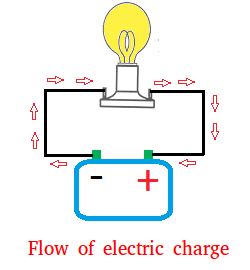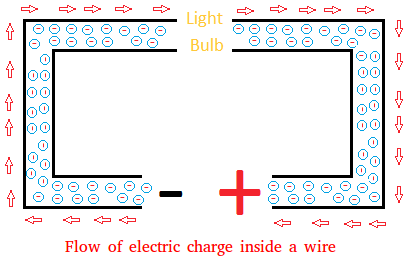Electric current
Simply put, the electric current is the flow of electric charge. The electric charge is carried through a circuit by electrons because electrons are free to move.
We call electrons that are free to move conduction electrons.
In the image below, we show a flow of electric charge
so things can be crystal clear in your mind. The red arrows shows the
direction.
At this point it may not clear why the electric charge flows this way. We can take a look inside the black wire to see what is going on.

Let
us pretend for a second that you could see the electrons inside the
wire. We will now focus on the wire shown in black to see what is going
on inside the wire.
Basically, the wire is usually made up of two things. A piece of metal where the electric current will flow. An insulator that surrounds the metal to prevent someone from getting hurt.
The piece of metal is made up of billions and billions and billions of atoms. Electrons are free to move in each atom.

We use circles and a negative sign inside the circles to represent electrons or conduction electrons inside the wire.
Recall that opposite charges attract each other. Therefore, the electrons in the conductor will be attracted to the positive terminal of the battery.
Now, you can clearly see why the flow of electric charge is shown this way in the first image.
Why does current flow in the opposite direction to electrons in physics textbooks?
In physics textbooks, the direction we described in this lesson is not the direction that you will see for the electric current. You will see the current flowing from positive to negative instead of negative to positive. Why is there a discrepancy between reality and what is done in practice?
Scientists used to think that current was due to a flow of positive charge and arbitrarily defined the current flow from positive to negative. Later on though it was discovered that the flow of charge is due to the movement of electrons from negative to positive.
Despite the discovery that that electrons move from the negative terminal to the positive terminal of a battery, scientists did not make any change due to convention.
SI unit of electric current
The unit used to measure the flow of electric current is the ampere. The symbol for ampere is A. This is the unit you will most likely see in textbooks.
1 ampere is the flow of 1 coulomb of charge every second. You could also say 1 coulomb of charge per second.
1 ampere is the electric current in 100-watt light bulb
1 coulomb is the electric charge of 6.24 billion billion electrons or 6.24 quintillion electrons.
That is a lot of electrons flowing inside a wire every second!